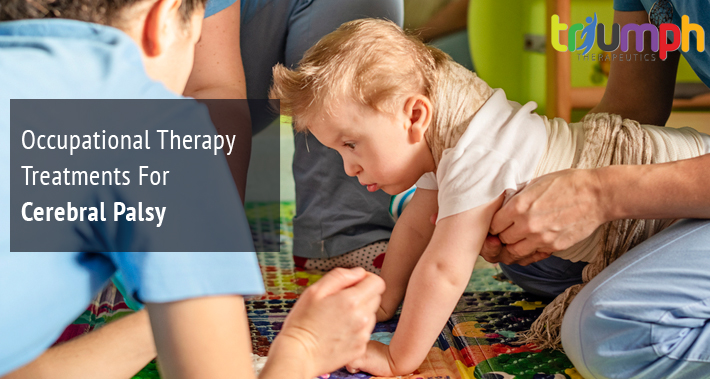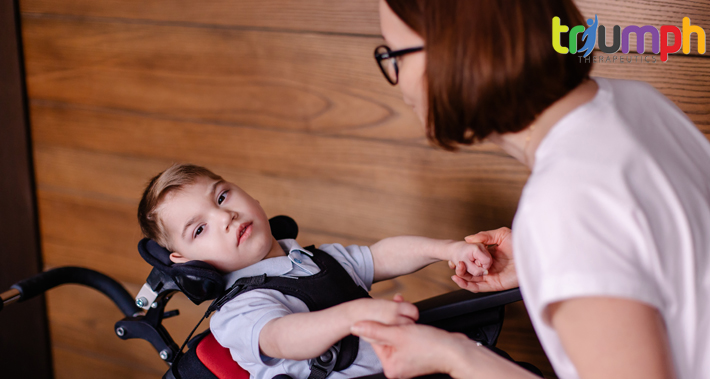Occupational Therapy Treatments For Cerebral Palsy
https://www.triumphtherapeutics.com/wp-content/uploads/2022/03/Triumph-Therapeutics-Speech-Therapy-OT-Physcial-Therapist-Washington-DC-Mar02-01-2022.jpg 710 379 Triumph Therapeutics Triumph Therapeutics https://www.triumphtherapeutics.com/wp-content/uploads/2022/03/Triumph-Therapeutics-Speech-Therapy-OT-Physcial-Therapist-Washington-DC-Mar02-01-2022.jpgCerebral palsy is a condition that can make everyday tasks, such as getting dressed or brushing your teeth, more difficult.
If your child has been recently diagnosed with cerebral palsy, you may be wondering about what their future will look like.
You may be worried what quality of life they will have.
Or perhaps you’re wondering if they will ever be able to live independently.
At Triumph Therapeutics, a pediatric therapy clinic in Washington DC, our occupational therapists are dedicated to helping improve quality life for both you and your child.
Keep reading to learn more about cerebral palsy and how pediatric occupational therapy services can help.
What Is Cerebral Palsy?
Cerebral palsy is not a single condition, but rather refers to various neurological conditions that impact movement and coordination.
Due to this variation, cerebral palsy will present differently in each child.
Cerebral palsy occurs either due to abnormal brain development, or brain damage that occurred before, during, or shortly after birth.
While cerebral palsy most commonly impacts movement and coordination, it may also affect other areas of your child’s function, such as cognition and learning, speech, and swallowing.
There is currently no known cure for cerebral palsy.
However, there are various treatments to help ensure that a child’s independence and quality of life is maximized.
Such treatments include:
- Pediatric speech therapy for cerebral palsy
- Pediatric physical therapy for cerebral palsy
- Surgery
- Medication
- Assistive technology like AAC or mobility devices
- Ensuring your home environment is best suited for your child’s needs
Different Types Of Cerebral Palsy
There are many different types of cerebral palsy.
Cerebral palsy is classified depending on the way brain damage affects the muscles throughout your child’s body.
Subsequently, the effects that cerebral palsy has on your child’s movement, posture, and function will vary.
Let’s look at some of the different types of cerebral palsy.
Ataxic Cerebral Palsy
Ataxic cerebral palsy is caused by damage in the part of the brain that controls balance and movement planning.
Ataxic cerebral palsy impacts gross and fine motor skill development, such as mobility and hand function.
If your child has ataxic cerebral palsy, you may notice that they experience with tremors or shakiness.
Depending on your child’s age, you may also notice that they have difficulties performing tasks that require precise finger movement, like writing or eating, or repetitive movements, like clapping.
Athetoid Cerebral Palsy
Athetoid cerebral palsy causes fluctuating muscle tone.
If your child has athetoid cerebral palsy, you may notice that they have trouble with controlling finer movements that require more effort, such as grasping objects.
You may also notice abnormalities in your child’s posture, swallowing, and speaking skills.
Diplegia
Diplegia is a form of cerebral palsy that primarily affects the lower limbs.
If your child has diplegia, you may also notice deficiency in other areas, such as hand function and visual perception.
Hemiplegia
If your child’s cerebral palsy is caused by hemiplegia, they will experience symptoms in only one side of their body.
Hemiplegia is caused by brain damage that occurred on the opposite side of the affected limbs.
Quadriplegia
Quadriplegia refers to cerebral palsy that affects the whole body, including all four limbs.
Spastic Cerebral Palsy
In spastic cerebral palsy, muscle stiffness due to high muscle tone results in difficult, slow movements in the affected areas of the body.
If your child has spastic cerebral palsy, they may struggle with getting dressed, bathing, using the bathroom, eating, drinking, writing, and holding objects.
How To Tell If Your Child Has Cerebral Palsy
If you suspect that your child is suffering with cerebral palsy, you should first book an appointment with a pediatrician or pediatric neurologist.
Your child’s physician will assess how your child is moving and behaving, as well as examine their brain through scans.
If your child has cerebral palsy, you may notice the following symptoms:
- Inability to move limbs, or unusual movement
- Delays in achieving developmental milestones
- Difficulty controlling muscles in the mouth to breast or bottle feed
- Difficulty having diaper changed or being dressed due to stiff limbs that are difficult to bend
- Holding one or both hands in a tightly clenched fist
It’s important to note that cerebral palsy has some overlap with other conditions, including congenital muscular torticollis, so it’s important to have your child undergo a pediatric therapy evaluation.
Additionally, cerebral palsy may affect your child’s muscle tone, mobility, and fine motor skills.
How Can Occupational Therapy For Cerebral Palsy Help Your Child?
The benefits of occupational therapy for cerebral palsy are numerous, and include:
- Increased chance of future independence
- Improvements in ability to play in learn
- Boosting of self esteem and confidence
- Helping with the creation of a workable routine
- Giving a sense of accomplishment
- Improvements in quality of life
Since cerebral palsy affects each child differently, the type of treatment provided in occupational therapy will be tailed to your child’s unique needs and limitations.
Your child’s occupational therapist will begin by taking a full assessment to see how your child’s cerebral palsy is affecting them.
Equal focus will be paid to your child’s abilities as well as their limitations.
Once the assessment is complete, your child’s occupational therapist will determine the best treatment plan.
Treatment options can include therapy exercises that focus on fine motor control, bilateral coordination, upper body strength and stability, visual motor skills and perception, and self care.
Additionally, there are numerous therapeutic techniques that your child’s occupational therapist may utilize in your child’s treatments.
For example, sensory integration therapy focuses on improving the ability to interpret sensory information through the use of sensory tools, such as silly putty.
Your child’s occupational therapist may also introduce the use of equipment to aid your child’s therapy, such as books, writing utensils, splints, toys and games.
Additionally, assistive devices, such as specialized feeding utensils and seating and positioning equipment, may also be utilized.
How Can Your Pediatric Occupational Therapist Help You Better Care For Your Child?
An occupational therapist can also help parents better learn how to care for their child.
For instance, your child’s occupational therapist can help educate you on structural building or assistive equipment in the home to better support your child’s needs.
Occupational therapy also offers many other benefits for parents, including:
- Reduced demand
- Reduced stress
- Providing a sense of security
- Improving quality of life
- Allowing you to watch your child improve and become independent
Book Your Appointment With Triumph Therapeutics Today
If your child has been diagnosed with cerebral palsy, they will need ongoing treatment.
Most children require reevaluation every six to nine months to gauge progress and alter treatment.
At Triumph Therapeutics, we want to be part of your child’s treatment.
Contact us today to book your first appointment.


